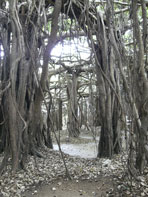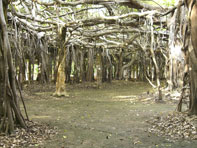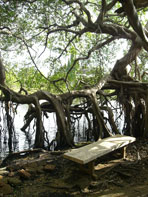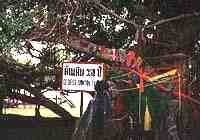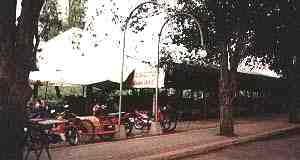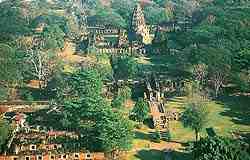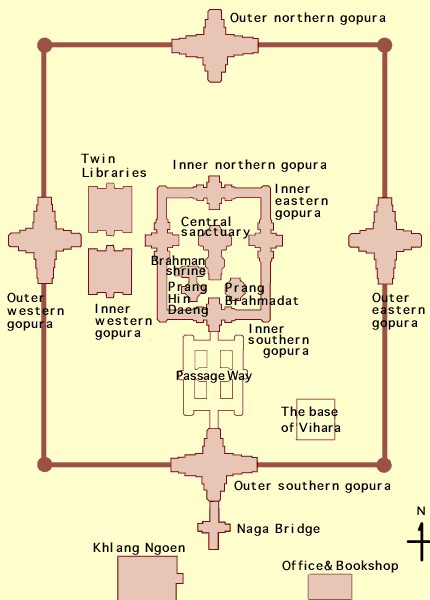"สะ พานโกลเดนเกท-Golden Gate" ความหมายคือ "ประตูทอง" ต้อนรับผู้มุ่งมาซานฟรานซิสโก ทำสถิติเป็นสะพานแขวนแห่งแรกที่ใหญ่ที่สุดในโลก เป็นเส้นทางสู่อ่าวซานฟรานซิสโก และเชื่อมระหว่างซานฟรานฯ กับมาริน เคาท์ตี
สะพาน ทาสีแดงอมส้มสดตามสีสัญลักษณ์ของซานฟรานฯ ใช้งบประมาณในการสร้าง 35 ล้านดอลลาร์ เริ่มก่อสร้างเมื่อวันที่ 5 มกราคม 1933 อันเป็นช่วงสมัยของประธานาธิบดีแฟรงกิน ดี. รูสเวลต์ มี โจเซฟ สเตราส์ เป็นวิศวกร ฝากฝีมือบันทึกไว้บนสะพานโกลเดน เกทสีแดงอมส้มที่จะเปล่งแสงสะท้อนเมื่อยามแสงอาทิตย์ตกกระทบ ความงามทางด้านวิศวกรรมได้รับการยกย่องจากสมาคมวิศวกรพลเรือนอเมริกันให้ เป็นหนึ่งใน 7 สิ่งมหัศจรรย์ของโลก
สะพานประตูทองทอดข้ามอ่าวทาง ตอนเหนือของเมืองซานฟรานฯ สร้างเป็นแบบโครงแขวน ตัวสะพานแขวนประกอบด้วยหอคอยเหล็กสองข้าง ข้างละ 215 เมตร ใช้ลวดเคเบิลโยงทอดเป็นตัวดึงน้ำหนักสะพาน มีขนาดเส้นผ่านศูนย์กลาง 36 นิ้ว ข้างละ 2 เส้น แต่ละเส้นประกอบด้วยลวนเส้นเล็กๆ 17,664 เส้น รวม 4 เส้น ยาว 70,815 ไมล์ หรือหมุนรอบโลกได้ 3รอบ และยังมีเส้นลวดเล็กยึดสายโยงอีกรวม 27,572 เส้น มีช่วงกลางระหว่างตอม่อยาว 1.26 กิโลเมตร ส่วนริม 2 ฟาก ยาวข้างละ 34 เมตร รวมความยาวทั้งหมดประมาณ 7 กิโลเมตร ส่วนกว้าง 27 เมตร
เนื้อที่ บนสะพานเปิดให้เดินรถไฟได้ 2 ช่องทาง และ 3 ช่องทางรถยนต์ โดยที่ตัวสะพานสามารถสามารถรับน้ำหนักได้ และไม่เกิดความเสียหาย เป็นสะพานแบบแขวนขนาดใหญ่และยาวมากที่สุดสะพานแรกในยุคนั้น สร้างแล้วเสร็จในเดือนเมษายน 1937 เปิดใช้ครั้งแรกวันที่ 28 พฤษภาคม ปีเดียวกัน โดยประธานาธิบดีรูสเวลต์กดปุ่มทำพิธีเปิดมาจากกรุงวอชิงตัน ดีซี เป็นสัญญาณให้ผู้ใช้รถสัญจรไปมาบนสะพานได้ ทั้งนี้ เมื่อวันแรกนั้นมีประชาชนราว 200,000 คน มารวมตัวกัน
ส่วนยุคตื่น ทองคำในสหรัฐเกิดขึ้นช่วง ค.ศ.1853 ผู้คนนับแสนหลั่งไหลเข้ารัฐแคลิฟอร์เนีย ยิ่งนานวันทวีจำนวนมากกว่า 250,000 คน สภาวการณ์ชุมชนเมืองระยะแรกเต็มไปด้วยคนนอกกฎหมาย ซานฟรานฯ ที่ในอดีตเคยเป็นของสเปนก็ได้กลายเป็นแหล่งชุมชนที่มั่งคั่งขึ้นจากการเป็น ศูนย์กลางการค้ายุคนั้น และยั่งยืนต่อมาแม้ทองจะหมดไปน้านนาน
สะพาน ทาสีแดงอมส้มสดตามสีสัญลักษณ์ของซานฟรานฯ ใช้งบประมาณในการสร้าง 35 ล้านดอลลาร์ เริ่มก่อสร้างเมื่อวันที่ 5 มกราคม 1933 อันเป็นช่วงสมัยของประธานาธิบดีแฟรงกิน ดี. รูสเวลต์ มี โจเซฟ สเตราส์ เป็นวิศวกร ฝากฝีมือบันทึกไว้บนสะพานโกลเดน เกทสีแดงอมส้มที่จะเปล่งแสงสะท้อนเมื่อยามแสงอาทิตย์ตกกระทบ ความงามทางด้านวิศวกรรมได้รับการยกย่องจากสมาคมวิศวกรพลเรือนอเมริกันให้ เป็นหนึ่งใน 7 สิ่งมหัศจรรย์ของโลก
สะพานประตูทองทอดข้ามอ่าวทาง ตอนเหนือของเมืองซานฟรานฯ สร้างเป็นแบบโครงแขวน ตัวสะพานแขวนประกอบด้วยหอคอยเหล็กสองข้าง ข้างละ 215 เมตร ใช้ลวดเคเบิลโยงทอดเป็นตัวดึงน้ำหนักสะพาน มีขนาดเส้นผ่านศูนย์กลาง 36 นิ้ว ข้างละ 2 เส้น แต่ละเส้นประกอบด้วยลวนเส้นเล็กๆ 17,664 เส้น รวม 4 เส้น ยาว 70,815 ไมล์ หรือหมุนรอบโลกได้ 3รอบ และยังมีเส้นลวดเล็กยึดสายโยงอีกรวม 27,572 เส้น มีช่วงกลางระหว่างตอม่อยาว 1.26 กิโลเมตร ส่วนริม 2 ฟาก ยาวข้างละ 34 เมตร รวมความยาวทั้งหมดประมาณ 7 กิโลเมตร ส่วนกว้าง 27 เมตร
เนื้อที่ บนสะพานเปิดให้เดินรถไฟได้ 2 ช่องทาง และ 3 ช่องทางรถยนต์ โดยที่ตัวสะพานสามารถสามารถรับน้ำหนักได้ และไม่เกิดความเสียหาย เป็นสะพานแบบแขวนขนาดใหญ่และยาวมากที่สุดสะพานแรกในยุคนั้น สร้างแล้วเสร็จในเดือนเมษายน 1937 เปิดใช้ครั้งแรกวันที่ 28 พฤษภาคม ปีเดียวกัน โดยประธานาธิบดีรูสเวลต์กดปุ่มทำพิธีเปิดมาจากกรุงวอชิงตัน ดีซี เป็นสัญญาณให้ผู้ใช้รถสัญจรไปมาบนสะพานได้ ทั้งนี้ เมื่อวันแรกนั้นมีประชาชนราว 200,000 คน มารวมตัวกัน
ส่วนยุคตื่น ทองคำในสหรัฐเกิดขึ้นช่วง ค.ศ.1853 ผู้คนนับแสนหลั่งไหลเข้ารัฐแคลิฟอร์เนีย ยิ่งนานวันทวีจำนวนมากกว่า 250,000 คน สภาวการณ์ชุมชนเมืองระยะแรกเต็มไปด้วยคนนอกกฎหมาย ซานฟรานฯ ที่ในอดีตเคยเป็นของสเปนก็ได้กลายเป็นแหล่งชุมชนที่มั่งคั่งขึ้นจากการเป็น ศูนย์กลางการค้ายุคนั้น และยั่งยืนต่อมาแม้ทองจะหมดไปน้านนาน
กระแส ตื่นทองยังทำให้ซานฟรานฯ กลายเป็นแหล่งคนงานทำเหมือง โดยเฉพาะอย่างยิ่งชาวจีนอพยพซึ่งนับเป็นรุ่นล่าสุดของอเมริกายุคหลังสงคราม กลางเมือง คนงานชาวจีนซึ่งส่วนใหญ่มาจากโรงยาฝิ่นลงเรือกลไฟแล่นข้ามมหาสมุทรแปซิฟิกมา ยังซานฟรานฯ ก่อนถูกกระจายไปตามเหมืองทองคำที่ต่างๆ ชาวจีนที่หลั่งไหลเข้าอเมริกาในช่วงตื่นทองนี้ ไม่เพียงทำให้อเมริกันเรียนรู้พลังของแรงงานผิวเหลืองจากเอเชียตะวันออก หากทำให้ชาวจีนเรียนรู้ที่จะอยู่ในวัฒนธรรมตะวันตกในเวลาต่อมาด้วย ชุมชนการค้าของชาวจีนในซานฟรานซิสโก กลายเป็นชุมชนขนาดใหญ่นับแต่นั้นจนวันนี้
Golden Gate Bridge History
The Golden Gate Bridge links San Francisco with Marin County in absolute splendor. The bridge is one of the architectural marvels of the Twentieth Century and a testament to human strife, as it was constructed during the years of the Great Depression. For years, the Golden Gate Bridge held the title as the longest suspension bridge in the world.
Before its completion in 1937, the bridge was considered impossible to build, due to persistently foggy weather, 60-mile-per-hour winds, and strong ocean currents, which whipped through a deep canyon below. In fact, the bridge is commonly known as the "Bridge that couldn't be built." Despite these unforgiving natural elements, the bridge was constructed in a little more than four years. The total cost was $35 million. The total length of the bridge spans 1.2 miles. Eleven men lost their lives during the construction of the bridge.
Even today, the massive spans of the bridge are often shrouded in fog. The bridge sways 27 feet to withstand winds of up to 100 miles per hour. International Orange was the color chosen for the bridge because it blended well with the bridge's natural surroundings. The two great cables extending from the bridge contain 80,000 miles of steel wire, which is enough to circle the equator three times. The concrete poured to cement the bridge into the stormy waters below could have also been used to pave a five-foot sidewalk from New York to San Francisco.
Because of the Golden Gate Bridge, San Francisco is one of the premier skyline cities in the nation. It was a triumphant day in the history of the city when the bridge was completed on May 27, 1937. Over 200,000 people celebrated the grand opening of the Golden Gate Bridge by walking its length. The following day, a dedication ceremony was held to officially christen what would become the architectural trademark of the city. The regular flow of vehicular traffic began the next day.
Efforts to begin the construction on the bridge began as early as 1928. The process would entail the efforts of six counties in Northern California. In 1928, the counties formed a Golden Gate Bridge and Highway District. In 1930, the voters appropriated a $35 million bond issue to finance the building of the bridge. For many years following, Joseph Baerman Strauss, a distinguished engineer, dreamed of raising a span across the Golden Gate. It was in response to his vision that people first started saying that the bridge could not be built. But, amazingly enough, Strauss held fast to his vision, and a span was eventually raised across the Golden Gate Bridge. The actual work on the bridge began on January 5, 1933. It was completed four-and-one-half years later. The result astounded the fiercest of Strauss's critics. To this day, the bridge is admired for its magnitude and beauty.
The bridge is nothing short of a powerful force meant to combat nature. The often mighty winds from the Pacific Ocean are sustained by a mid span swing of 27 feet. The two towers of the bridge rise an impressive 746 feet, which is 191 feet taller than the Washington Monument. The pier of the bridge is only 1,215 feet from the shore, the distance between the two towers that support the cables, which in turn, support the floor of the bridge is 4,200 feet. These two cables are the largest bridge cables ever made at a little over 361 feet in diameter.
Today, pedestrians and bicyclists are still allowed to cross the bridge on pathways with breathtaking views of the city, Alcatraz, and the Marin Headlands. The bridge toll for vehicles is $3 when entering San Francisco.
The first exit of the Marin side of the bridge is Visa Point, which provides a magnificent view of the San Francisco skyline. But, the best way to view the bridge is to walk across.









